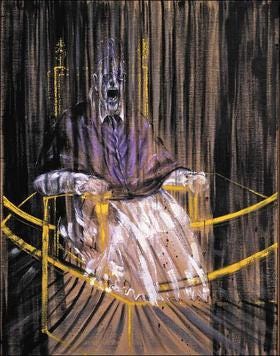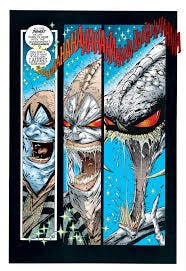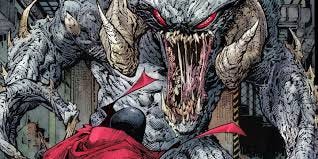Kā tangi te tītī
Kā tangi te kākā
Kā tangi hoki ahau
“'Twas brillig, & the slithy toves
Did gyre & gimble in the wabe;
All mimsy were the borogoves,
& the mome raths outgrabe.”
— Jabberwocky by Lewis Carroll
The painting Study after Velázquez's Portrait of Pope Innocent X by Francis Bacon stands like a body undressed before a baptism of colour. Flesh does not lie dormant here. It bursts forward as fire caught in oil. The canvas trembles with epidermis stretched taut across bone. The artist's wrist, a tendon strung with memory, delivers strokes that spill like blood in dreamtime. Veins have become brushstrokes, coursing beneath the surface, blue with loss, red with defiance. A face emerges, not human yet undeniably born of flesh. The mouth is a wound, the eyes two sockets of unspoken things. The whole image pulses like a ribcage in storm, breathing pigment, exhaling silence. It is the body in rupture, in exultation, in mute witness. Words are not required here. They slough off like dead skin. They cannot survive the fever. Only colour speaks & it speaks in tongues that cannot be pinned.
The tale of Violator (Image, 1994) proceeds not as narrative but as dissection. Not with silk gloves & polite euphemism, but with bones cracked wide & organs left steaming on the table. It is a vivisection without anaesthetic, without mercy, without the decency of final death. Fiat voluntas tua, translation: “let thy will be done.” The will here is Hell’s. The execution is surgical. The comic’s corpus opens with the Clown, known to his siblings by his true nom de guerre, the Violator. A creature of rank odium, expelled from the infernal tribunal of his own blood: the Phlebiac Brothers. In issue 1 of Violator (Image, 1994), the ecclesia damnata, the cursed church of the Darklands, strips him of his powers with all the tenderness of a tax audit. His musculature sloughs off like cooked meat. His bones creak beneath the weight of unholy exile. They cast him out, not into fire, but into New York City, which is arguably worse. He lands in the slums like a ruptured spleen dumped behind a butcher’s shop. Ex nihilo nihil fit, translation: “nothing comes from nothing.” Unless, of course, you are a demon in pinstripes. In issue 2 of Violator (Image, 1994), the G-Men from Hell arrive. Max & Toby. Once mortals, now stitched together like bureaucratic homunculi. Their skin peels. Their badges glow. Their presence smells faintly of cordite & bad decisions. They chase the Clown not out of justice, but because someone in management wrote it on a form & no one wanted to challenge the flowchart. Contra principia negantem non est disputandum, translation: “against one who denies the principles, there can be no debate.” Which, in this case, applies to reality itself. Meanwhile, Don Bernini, a man with the silhouette of a boiled ham, lumbers into view. He speaks in vowels soaked with marinara. His suit strains to contain his sins.
His underlings move like platelets around an arterial clot. In the world of crime, Bernini is the cholesterol. He smells of cheap cologne, cheaper meatballs, & the sort of family values that end with cement shoes. His rise is less meteoric & more metastatic. In issue 3 of Violator (Image, 1994), the Clown begins to stir. Though de-powered, he manipulates the criminal underworld with the dexterity of a pickpocket & the sensibility of a mad surgeon. He inserts himself into Bernini’s empire like a parasite with a doctorate in chaos. The jokes he tells are neither funny nor forgivable. They hang in the air like flatulence in a church pew. Caveat emptor, translation: “let the buyer beware.” The Clown is selling mayhem by the litre. By issue 4 of Violator (Image, 1994), the brothers descend. Not with trumpets, but with claws. Tremor, Vindicator, Vacillator, Vaporizer, & Vandalizer. Five horsemen without the horses. Each grotesque in form & function. One resembles a tumour that studied theology. Another moves like arthritis made flesh.
They do not speak justice. They speak in ululations. In bile. They rip through New York’s bowels with ecclesiastical fervour. Seeking not their brother’s salvation, but his obliteration. Fiat justitia ruat caelum, translation: “let justice be done though the heavens fall.” Or in this case, let the city burn though the paperwork is delayed. In issue 5 of Violator (Image, 1994), the Clown is reborn. His wit returns first. Then his bile. Then his body, swelling grotesquely into its former shape like an ulcer refilling with pus. Muscles bulge. Eyes gleam. Teeth reassert themselves with malicious precision. He defeats his brothers not with honour, but with guile. A classic case of cave canem, translation: “beware of the dog,” though in this instance the dog wears clown makeup & eats angels for breakfast. The G-Men perish, either forgotten or simply shredded. The brothers retreat, bruised & sermonless. The city haemorrhages in peace, & Violator walks. Not with dignity, but with rhythm. Every footfall a reminder that Hell does not end. It relocates. Ubi fumus, ibi ignis, translation: “where there is smoke, there is fire.” Where there is the Clown, there is a charred punchline waiting to be delivered. Herein, the whisper of Mātua Jacques Derrida may be heard not in the voice, but in the twitch. It lives in the cartilage, in the soft tissue of contradiction, in the way the Violator moves with the gait of dislocated meaning. He does not speak. He leaks. Every syllable he utters is an abscess. Every gesture a cyst blooming with semantic rot. The G-Men wear their badges like dried scabs, signals of a state long since embalmed. Don Bernini issues commands with the authority of a corpse giving legal testimony.
The Phlebiac Brothers judge with all the solemnity of infected lymph nodes arguing about piety. Fiat lex, pereat mundus, translation: “let the law be made, though the world perish.” The law here is hollow cartilage, cracked & whimpering. The world has already perished. Nobody noticed. The Clown dances not because he is joyful, but because entropy needs choreography. Death is the only certainty, yes, but even it is not punctual. The grave is a punchline. The eulogy, a footnote. The Clown does not mock death. He is death after a three-drink lunch. In vino veritas, translation: “in wine, truth.” In the Clown, fermentation. “There is nothing outside the text,” says Mātua Jacques Derrida, the anatomist of absence, the pathologist of presence. The Clown is not within the text. He is the text. Not bound by page, but tattooed across its every torn sinew. His flesh stretches like unfinished parchment, flayed yet endless. His jokes rupture meaning, not to destroy it, but to show the pus beneath the skin of comprehension. Ipsissima verba, translation: “the very words themselves.” But the Clown’s words wear masks. Behind each is another. Then another. Then a void, grinning. The grin is a wound. Not symbolic. Not metaphorical. A literal gash across the corpus of language.
Ad absurdum, translation: “to the point of absurdity.” Which is also the Clown’s address, his birthplace, his citizenship. The Phlebiac Brothers, with their theologies of sinew & rage, attempt to contain him. But containment presupposes content. Mātua Derrida reminds us, ever the obstetrician of doubt, that presence is deferred. Permanently. The Clown arrives not late, but always after. After the punchline, after the meaning, after the corpse has gone cold. Post hoc, ergo propter hoc, translation: “after this, therefore because of this.” The comic believes it governs causality. The Clown shows it only governs decay. In Violator, every wound is not only a glyph, but also a grammar. Syntax coagulates in the bloodied gaps. Screams form clauses. Silence punctuates with bruises. Flesh becomes palimpsest, layered & rewritten, though never cleansed. Limbs contort like participles in theological Latin, snarled in their own declensions.
The comic does not conclude. It does not arc. It scars. Morituri te salutant, translation: “those who are about to die salute you.” The Clown salutes no one. He curtsies with a chainsaw. So it is that the Clown walks. Not with malice. Not with grace. With inevitability. He is not villain. He is not victim. He is the errata. He is the footnote where God miswrote the species. The scarred parchment of différance itself, not error, but delay. Not absence, but the wound that proves presence never arrived. His body a grammar of exposed nerves. His grin a yawning semicolon, forever refusing to end the sentence. His story is a corpus without logos. An anatomy of error. A theology of phlegm. Errare humanum est, translation: “to err is human.” The Clown is profoundly human. That is the horror.
Nō reira, tēnā koutou, tēnā koutou, tēnā koutou katoa!









